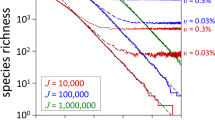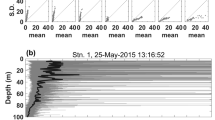Abstract
In a classical paper, Hutchinson (1961) argued that the large number of species in most plankton communities is remarkable in view of the competitive exclusion principle, which suggests that in homogeneous, well-mixed environments species that compete for the same resources cannot coexist. Few ideas in aquatic ecology have evoked more research than this `paradox of the plankton'. This review is an effort to put the main solutions to the paradox that have been proposed over the years into perspective. Hutchinson himself already suggested that the explanation could be that plankton communities are not in equilibrium at all due to weather-driven fluctuations. Subsequent research confirmed that such externally imposed variability can allow many species to coexist. Another important point is that in practice the homogeneous well-mixed conditions assumed in the competitive exclusion principle hardly exist. Even the open ocean, for instance, has a spatial complexity resulting from meso-scale vortices and fronts that can facilitate coexistence of species. Perhaps most excitingly, theoretical work on species interactions has given a counter-intuitive new dimension to the understanding of diversity. Various competition and predation models suggest that even in homogeneous and constant environments plankton will never settle to equilibrium. Instead, interactions between multiple species may give rise to oscillations and chaos, with a continuous wax and wane of species within the community. Long-term laboratory experiments support this view. This chaotic behavior implies among other things that plankton dynamics are intrinsically unpredictable in the long run when viewed in detail. Nonetheless, on a higher aggregation level, indicators such as total algal biomass may show quite regular patterns.
Similar content being viewed by others
References
Alekseev, V. V. & A. N. Kornilovsky, 1985. Ecosystems stochasticity model. Ecol. Model. 28: 217-230.
Armstrong, R. A. & R. McGehee, 1980. Competitive exclusion. Am. Nat. 115: 151-170.
Arneodo, A., P. Coullet, J. Peyraud & C. Tresser, 1982. Strange attractors in Volterra equations for species in competition. J. Math. Biol. 14: 153-157.
Bjørnstad, O. N. & B. T. Grenfell, 2001. Noisy clockwork: time series analysis of population fluctuations in animals. Science 293: 638-643.
Boersma, M., 1995. Competition in natural populations of Daphnia. Oecologia 103: 309-318.
Bracco, A., A. Provenzale & I. Scheuring, 2000. Mesoscale vortices and the paradox of the plankton. Proc. r. Soc. Lond. B 267: 1795- 1800.
Brooks, J. L. & S. I. Dodson, 1965. Predation, body size, and composition of plankton. Science 150: 28-35.
Buss, L. W. & J. B. C. Jackson, 1979. Competitive networks: nontransitive competitive relationships in cryptic coral reef environments. Am. Nat. 113: 223-234.
Cottingham, K. L., 1996. Phytoplankton responses to whole-lake manipulations of nutrients and food webs. Thesis, University of Wisconsin.
DeFeo, O. & S. Rinaldi, 1998. Singular homoclinic bifurcations in tritrophic food chains. Math. Biosci. 148: 7-20.
DeMott, W. R., 1982. Feeding selectivities and relative ingestion rates of Daphnia and Bosmina. Limnol. Oceanogr. 27: 518-527.
Doveri, F., M. Scheffer, S. Rinaldi, S. Muratori & Y. A. Kuznetsov, 1993. Seasonality and chaos in a plankton-fish model. Theor. Popul. Biol. 43: 159-183.
Ellner, S. & P. Turchin, 1995. Chaos in a noisy world: new methods and evidence from time-series analysis. Am. Nat. 145: 343-375.
Fernández, A., S. Huang, S. Seston, J. Xing, R. Hickey, C. Criddle & J. Tiedje, 1999. How stable is stable? Function versus community composition. Appl. Environ. Microbiol. 65: 3697-3704.
Flöder, S. & U. Sommer, 1999. Diversity in planktonic communities: an experimental test of the intermediate disturbance hypothesis. Limnol. Oceanogr. 44: 1114-1119.
Gilpin, M. E., 1979. Spiral chaos in a predator-prey model. Am. Nat. 113: 306-308.
Gragnani, A., M. Scheffer & S. Rinaldi, 1999. Top-down control of cyanobacteria: a theoretical analysis. Am. Nat. 153: 59-72.
Grover, J. P., 1989. Effects of Si:P supply ratio, supply variability, and selective grazing in the plankton: an experiment with a natural algal and protistan assemblage. Limnol. Oceanogr. 34: 349-367.
Gulati, R. D., E. H. R. R. Lammens, M. L. Meijer & E. van Donk (eds), 1990. Biomanipulation, Tool for Water Management. Kluwer Academic Publishers, Dordrecht, The Netherlands: 628 pp.
Gulati, R. D., A. L. Ooms-Wilms, O. F. R. van Tongeren, G. Postema & K. Siewertsen, 1992. The dynamics and role of limnetic zooplankton in Loosdrecht Lakes (The Netherlands). Hydrobiologia 233: 69-86.
Hastings, A. & T. Powell, 1991. Chaos in a three-species food chain. Ecology 72: 896-903.
Hastings, A., C. L. Hom, S. Ellner, P. Turchin & H. C. J. Godfray, 1993. Chaos in ecology - is mother nature a strange attractor? Ann. Rev. Ecol. Syst. 24: 1-33.
Heerkloss, R. & G. Klinkenberg, 1998. A long-term series of a planktonic foodweb: a case of chaotic dynamics. Verh. int. Ver. Limnol. 26: 1952-1956.
Hogeweg, P. & B. Hesper, 1978. Interactive instructions on population interactions. Comp. Biol. Med. 8: 319-327.
Hubbell, S. P., 2001. The Unified Neutral Theory of Biodiversity and Biogeography. Princeton University Press, Princeton: 375 pp.
Huisman, J. & F. J. Weissing, 1999. Biodiversity of plankton by species oscillations and chaos. Nature 402: 407-410.
Huisman, J. & F. J. Weissing, 2001a. Fundamental unpredictability in multispecies competition. Am. Nat. 157: 488-494.
Huisman, J. & F. J. Weissing, 2001b. Biological conditions for oscillations and chaos generated by multispecies competition. Ecology 82: 2682-2695.
Huisman, J. & F. J. Weissing, 2002. Oscillations and chaos generated by competition for interactively essential resources. Ecol. Res. 17: 175-181.
Huisman, J., A. M. Johansson, E. O. Folmer & F. J. Weissing, 2001. Towards a solution of the plankton paradox: the importance of physiology and life history. Ecol. Lett. 4: 408-411.
Huisman, J., R. R. Jonker, C. Zonneveld & F. J. Weissing, 1999. Competition for light between phytoplankton species: experimental tests of mechanistic theory. Ecology 80: 211-222.
Hutchinson, G. E., 1941. Ecological aspects of succession in natural populations. Am. Nat. 75: 406-418.
Hutchinson, G. E., 1961. The paradox of the plankton. Am. Nat. 95: 137-145.
Jackson, J. & L. Buss, 1975. Allelopathy and spatial competition among coral reef invertebrates. Proc. natl. Acad. Sci. U.S.A. 72: 5160-5163.
Kersting, K., 1985. Properties of an aquatic micro-ecosystem. V. Ten years of observations of the prototype. Verh. int. Ver. Limnol. 22: 3040-3045.
Kuznetsov, Y. A. & S. Rinaldi, 1996. Remarks on food chain dynamics. Math. Biosci. 134: 1-33.
Litchman, E., 1998. Population and community responses of phytoplankton to fluctuating light. Oecologia 117: 247-257.
Lloyd, A. L. & D. Lloyd, 1995. Chaos: its significance and detection in biology. Biol. Rhythm Res. 26: 233-252.
Lorenz, E. N., 1964. The problem of deducing the climate from the governing equations. Tellus 16: 1-11.
McCauley, E. & W. W. Murdoch, 1987. Cyclic and stable populations: plankton as a paradigm. Am. Nat. 129: 97-121.
McGrady-Steed, J., P. M. Harris & P. J. Morin, 1997. Biodiversity regulates ecosystem predictability. Nature 390: 162-165.
Naeem, S. & S. Li, 1997. Biodiversity enhances ecosystem reliability. Nature 390: 507-509.
Padisák, J., C. S. Reynolds & U. Sommer (eds), 1993. Intermediate Disturbance Hypothesis in Phytoplankton Ecology. Kluwer Academic Publishers, Dordrecht, The Netherlands: 199 pp.
Remmert, H. (ed.), 1991. The Mosaic-Cycle Concept of Ecosystems. Springer Verlag, Berlin.
Reynolds, C. S., 1993. Scales of disturbance and their role in plankton ecology. Hydrobiologia 249: 157-171.
Reynolds, C. S., J. Padisák & U. Sommer, 1993. Intermediate disturbance in the ecology of phytoplankton and the maintenance of species diversity: a synthesis. Hydrobiologia 249: 183-188.
Richerson, P. J., R. Armstrong & C. R. Goldman, 1970. Contemporaneous disequilibrium: a new hypothesis to explain the paradox of the plankton. Proc. natl. Acad. Sci. U.S.A. 67: 1710-1714.
Rinaldi, S. & S. Muratori, 1993. Conditioned chaos in seasonally perturbed predator-prey models. Ecol. Model. 69: 79-97.
Rinaldi, S., S. Muratori & Y. Kuznetsov, 1993. Multiple attractors, catastrophes and chaos in seasonally perturbed predator-prey communities. Bull. Math. Biol. 55: 15-35.
Ringelberg, J., 1977. Properties of an aquatic micro ecosystem II. Steady-state phenomena in the autotrophic subsystem. Helgolander wiss. Meeresunters. 30: 134-143.
Rogers, T. D., 1981. Chaos in systems in population biology. Progr. Theor. Biol. 6: 91-146.
Rothhaupt, K. O., 1988. Mechanistic resource competition theory applied to laboratory experiments with zooplankton. Nature 333: 660-662.
Rothhaupt, K. O., 1996. Laboratory experiments with a mixotrophic chrysophyte and obligately phagotrophic and phototrophic competitors. Ecology 77: 716-724.
Scheffer, M., 1991. Should we expect strange attractors behind plankton dynamics: and if so, should we bother? J. Plankton Res. 13: 1291-1305.
Scheffer, M., S. Rinaldi, A. Gragnani, L. R. Mur & E. H. van Nes, 1997a. On the dominance of filamentous cyanobacteria in shallow, turbid lakes. Ecology 78: 272-282.
Scheffer, M., S. Rinaldi, Y. A. Kuznetsov & E. H. van Nes, 1997b. Seasonal dynamics of Daphnia and algae explained as a periodically forced predator-prey system. Oikos 80: 519-532.
Scheffer, M., D. Straile, E. H. van Nes & H. Hosper, 2001. Climatic warming causes regime shifts in lake foodwebs. Limnol. Oceanogr. 46: 1780-1783.
Smale, S., 1976. On the differential equations of species in competition. J. Math. Biol. 3: 5-7.
Sommer, U., 1985. Comparison between steady state and nonsteady state competition: experiments with natural phytoplankton. Limnol. Oceanogr. 30: 335-346.
Sommer, U., 1986. Nitrate-and silicate-competition among Antarctic phytoplankton. Mar. Biol. 91: 345-351.
Sommer, U., 1991. Phytoplankton: directional succession and forced cycles. In Remmert, H. (ed), The Mosaic-Cycle Concept of Ecosystem. Springer Verlag, Berlin: 132-146.
Sommer, U., Z. M. Gliwicz, W. Lampert & A. Duncan, 1986. The PEG-model of seasonal succession of planktonic events in fresh waters. Arch. Hydrobiol. 106: 433-471.
Stone, L., G. Landan & R. M. May, 1996. Detecting time”s arrow: a method for identifying nonlinearity and deterministic chaos in time-series data. Proc. r. Soc. Lond. B 263: 1509-1513.
Sugihara, G. & R. M. May, 1990. Nonlinear forecasting as a way of distinguishing chaos from measurement error in time series. Nature 344: 734-741.
Takeuchi, Y. & N. Adachi, 1983. Existence and bifurcation of stable equilibrium in two-prey, one-predator communities. Bull. Math. Biol. 45: 877-900.
Tilman, D., 1977. Resource competition between planktonic algae: an experimental and theoretical approach. Ecology 58: 338-348.
Tilman, D., 1981. Tests of resource competition theory using four species of Lake Michigan algae. Ecology 62: 802-815.
Tilman, D., 1996. Biodiversity: population versus ecosystem stability. Ecology 77: 350-363.
Turchin, P. & A. D. Taylor, 1992. Complex dynamics in ecological time series. Ecology 73: 289-305.
Vance, R. R., 1978. Predation and resource partitioning in one predator-two prey model communities. Am. Nat. 112: 797-813.
VanBuskirk, R. & C. Jeffries, 1985. Observation of chaotic dynamics of coupled nonlinear oscillators. Phys. Rev. A 31: 3332-3357.
Van Gemerden, H., 1974. Coexistence of organisms competing for the same substrate: an example among the purple sulfur bacteria. Microb. Ecol. 1: 104-119.
VanderMeer, J., 1993. Loose coupling of predator-prey cycles: entrainment, chaos, and intermittency in the classic MacArthur consumer-resource equations. Am. Nat. 141: 687-716.
Wilson, H. B. & D. A. Rand, 1993. Detecting chaos in a noisy time series. Proc. r. Soc. Lond. B 253: 239-244.
Author information
Authors and Affiliations
Rights and permissions
About this article
Cite this article
Scheffer, M., Rinaldi, S., Huisman, J. et al. Why plankton communities have no equilibrium: solutions to the paradox. Hydrobiologia 491, 9–18 (2003). https://doi.org/10.1023/A:1024404804748
Issue Date:
DOI: https://doi.org/10.1023/A:1024404804748




